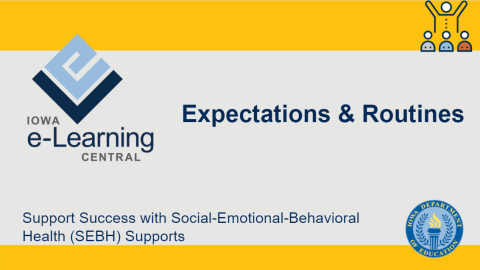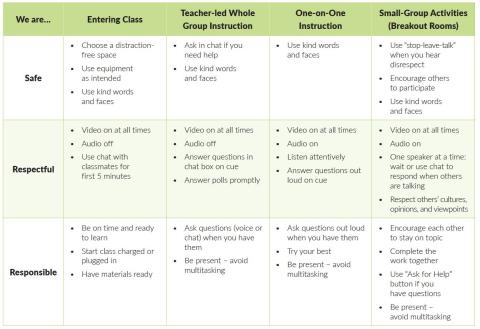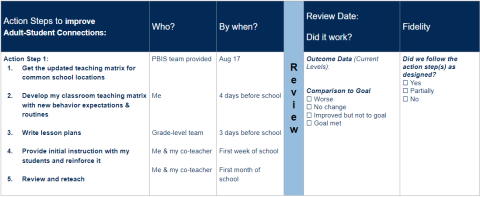
Click the link below
for the Expectations & Routines module
The full version of the module is in the downloadable PDF above. An accessible text version is below.
Support Success with Social-Emotional-Behavioral Health (SEBH) Supports - Expectations & Routines
Information on the importance of establishing and using consistent expectations and routines in instructional models.
Purpose & Objectives
This is one of a set of modules that highlight critical considerations and provide universal strategies to support the social-emotional-behavioral health of staff, students, and families during in-person and/or online learning.
Each module is:
- a “jump-start” to key considerations, with less focus on systemic changes
- designed to be completed in
30 minutes or less - for educators/teachers
- self-paced but may be facilitated
- optional; educators may use one or more depending on need
Supporting Social-Emotional-Behavioral Health
Staff, family, and student emotional well-being is integral to effective instruction and student engagement. Planning for this support is critical to ensure adults and learners are ready to learn.
Teachers with Strong Social-Emotional Competence...
- Have less burnout
- Have stronger student relationships
- Regulate their own emotions
- Are social-emotional role models
Students with Strong Social-Emotional Competence...
- Have increased achievement
- Have improved attitudes
- Have less emotional distress
- Have fewer conduct concerns
Alignment to State Priorities and Goals
State Priority: Creating a Safe, Healthy, and Welcoming Learning Environment
- Goal: All Iowa schools will work with their learners to foster a culture and climate in which they feel safe and supported, and bullying and harassment do not exist.
- Goal: All learners will have access to mental health services and supports in their schools and communities.
- Goal: All schools will create environments that develop social, emotional, and behavioral health.
- Goal: All schools will develop physical health for students through structured school programs (e.g., food and nutrition, physical education, wellness programs, etc.)
Connecting to your work
How do these recommendations connect to your work?
The practices outlined in the following modules align to:
- Best practices detailed within many policy expectations for schools
- Evidence Based Practices (EBPs) for SEBH
- Universal Supports for SEBH within an MTSS
The purpose of these resources is to apply EBP for SEBH within the context of a variety of learning contexts including in-person, online, and virtual.
Behavioral Expectations & Routines
Objectives
- Understand how to establish and communicate clear expectations and routines in all learning contexts.
- Outline plan for teaching routines and behavioral expectations in all learning contexts.
- Identify methods for recognizing efforts.
Key Terms and Definitions
- Expectations: Broad statements that apply to all people in all settings. Typically schools identify 3-5 School-wide expectations exemplifying the vision of the school. Classroom expectations can be based on school-wide expectations or can be determined by the teacher to meet the needs of their classroom.
- Rules: Observable, measurable, positively stated, applicable, and understandable; prosocial examples for each expectation.
- Routines: Procedures that have been learned to fluency. Consider routines for external behaviors (e.g. turning in assignments, etc.), and social-emotional skills (e.g. self-awareness, brain regulation, developing relationships, etc.).
- Specific Positive Feedback: Verbal reinforcement; a form of social reinforcement that provides information on successful behavior while reinforcing or increasing the likelihood that behavior will be repeated; combines social attention, instruction, and reinforcement.
- Acknowledgment: Something that reinforces a desired behavior, most often a preferred tangible/object or activity; often used interchangeably with “reinforcement.” Combine with specific, positive feedback, aligned with School-Wide and/or Classroom Expectations.
Why Set and Teach Behavioral Expectations and Routines?
- Teaching and modeling expected behaviors helps establish and maintain a culture in which students can expect to see prosocial behavior from their peers and other adults.
- Using predictable routines helps students maintain a sense of psychological safety. Alerting them to potential changes in those routines helps to reduce student stress.
- Lastly, teaching and reinforcing expectations and routines has been shown to decrease problem behavior and have a positive impact on academics.
Determine Your Classroom Expectations
Steps to Determine Your Expectations
- Think about the behaviors and attitudes you want to see from your students this year whether you are in school or online.
- Identify words and phrases that represent your desired classroom behaviors and attitudes.
- Narrow your list down to the 3–5 that are the most important to you.
- Verify that they meet the criteria for expectations.
You can use the advanced organizer to take notes or to develop your own expectations.
Teaching Expectations and Routines
Watch the video and reflect on these questions:
- Why is it important to teach your students your expectations and the routines you want them to use in your classroom?
- How is teaching behavior like teaching academics?
Develop Your Teaching Matrix
Steps to Develop Your Teaching Matrix
- Identify the locations you have in your building and/or the routines you have in your classroom.
- For each corresponding pair (expectation x location), identify the specific behavior(s) that you want to teach and see from your students. The behaviors listed should be 1–2 of the most important ones for that expectation x location (ex. respect x hallways) and should be:
- Observable – I can see it
- Measurable – I can count it
- Positively stated – I tell students what TO do
- Understandable – Age and grade appropriate, student-friendly language
You can use the advanced organizer to take notes or to develop your own expectations.
Sample Expectations & Routines
Review the completed advanced organizer from Mrs. B
- What desired behaviors do you want from your students? Do your ideas match what Mrs. B wrote?
- What expectations would you have picked if you were Mrs. B?
- What other locations or routines might you add to the teaching matrices?
View examples of early childhood, elementary, and secondary teaching matrices. Other examples may help give you ideas on what you might want to add to your own matrix for your classroom.
Teaching Expectations and Routines
- Staff should identify the behaviors and routines that students that they would like their students to demonstrate (in-person and/or online).
- These specific behaviors or routines should align to your 3–5 expectations
- Update or create a new teaching matrix for your classroom
Remember, if your school has a schoolwide PBIS or school culture team, they may provide you with an updated teaching matrix. Be sure to ask before you create your own.
Teaching Matrix
- Steps to update your Teaching Matrix
- Identify the teaching context (e.g. in-person, online) you have and/or any new routines you need to teach
- For each corresponding pair (expectation x location/situation), identify the specific behavior(s) that you want see from your students and teach them
Once you complete the module, use these resources as part of your action plan to complete your own Teaching Matrix for your classroom.
Your Teaching Matrix for Online Learning
Online
Consider online learning as new locations for your matrix. Examples include:
- Getting ready for virtual learning
- Entering the online classroom
- Whole group instruction
- Small group breakouts
- Exiting the virtual classroom & independent work
- Virtual office hours
Add new routines that you will use online with your students. Examples include:
- How to use chat, reactions, audio, video
- Accessing virtual resources
- Process to ask a question
- How to turn in homework virtually
Consider what you may want to include in your teaching matrix if teaching an online class. Here are some online learning examples and resources to help you update the teaching matrix for your online classroom.
Example Teaching Matrix for Online Learning
Review the example and reflect on these questions:
- What expectations and routines do you need to teach if you are in-person?
- What expectations and routines do you need to teach if your students are learning online?

Taken from pbis.org – Creating a PBIS Behavior Teaching Matrix for Remote Instruction
Use Your Matrix to Guide Your Instruction
- You will need to explicitly teach your classroom expectations and the specific desired behaviors and routines to your students
- Teach these expectations in the same way you teach academics
- Use an I DO, WE DO, YOU DO instructional format
- Use examples and nonexamples in instruction – This helps students distinguish the line between what is and isn’t acceptable
- Teach initially and teach over time as needed – Teaching one time probably won’t be enough to ensure that all students know and can demonstrate the expected behaviors. Repeated instruction helps build understanding.
- Practice, practice, practice – Practice builds fluency in using the new routines and behavior
- Pre-correct for the behaviors you want to see in class
Behavior Lesson Plan Template
As you watch the video:
- What expectation was he teaching?
- What is the location?
- What was his rationale?
- How did he teach it?
- How did he have students practice?
You can use a lesson plan template like this one to help you plan your instruction. If you don’t already have a template for teaching behaviors and routines, how might you use this?
Handout: Lesson Plan Template
Teach and Reinforce the Expected Behaviors
- f you take the time to teach it, take the time to reinforce it too!
- Provide specific, positive feedback for expected behaviors and following routines
- Plan to provide positive feedback 4 times more than corrective feedback as relationships are more successful with more positive interactions
Steps to Provide Feedback
- Observe the expected student behavior/routine
- Acknowledge the specific behavior/routine
- Link it to the expectation
- Provide the reinforcement
Tips on Providing Feedback
DO
- Be specific
- Tie feedback to the expectation
- Be sincere
DON’T
- Give general feedback like “good job” or “way to go”
- Only give feedback for ‘above and beyond’ behaviors
Planning for Acknowledgment
Lesson Plan Includes:
- Defining
- Modeling or Showing
- Practicing
- Giving Feedback
- Adjusting/Reteaching
This lesson plan (from Slide 21) also includes a section to help you plan to acknowledge expected behavior. How might you use this to plan to reinforce the behaviors and routines you want to see in your class this year?
Handout: Lesson Plan Template
Reflection: Equity Considerations ~ Culturally Responsive
- Expectations and routines take into consideration the differences in behavioral expectations with respect to other cultures.
- School teams include family/student subcommittees to reflect diverse voices.
- Teachers/teams focus on changing the system rather than the students and engage in explicit conversations around ethnicity/race and effects of practices on all student enrollment groups.
- Expectations and rules are included in family and student orientation materials, including explicit statements on possible differences between school and home.
Example: Action Plan
This slide shows an example action plan to update your teaching matrix and plan for initial instruction.

Follow Up Activity – It’s Your Turn
- Use existing schoolwide expectations or develop your own expectations for your classroom
- Update or create your classroom teaching matrix
- Develop lesson plans to teach and reinforce expectations, behaviors, and routines this fall
Behavioral Expectations & Routines – Additional Activities (Optional)
The following activities are suggested to support implementing these practices within your school:
Activity 1 (Optional)
WHAT IS IT? The Student/Teacher Game is a quick and easy strategy to prompt and acknowledge students for following expectations in the classroom.
WHY DO IT? The Game encourages appropriate behaviors by “catching” students engaged in expected behaviors and has been shown in research and practice to improve behavior.
Activity 2 (Optional)
Teaching Expectations Considerations
WHAT IS IT? This document will help you identify things to consider when teaching behavior expectations to students, not only at the beginning of the year, also throughout the year.
WHY DO IT? Teaching behavior expectations includes more than just telling students what to do. It also includes providing feedback and monitoring if the students have learned them.